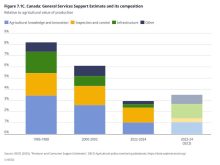“Farmers are already overpaying the
railways so this extra seven per cent just adds insult to injury.”
– JOHN LYONS
Western farmers are likely to pay more to ship their grain by rail in the new crop year starting Aug. 1 due to higher railway operating costs.
Many farmers believe they already pay too much. That’s why farm groups and the Canadian Wheat Board have been calling for a review of railway costs.
The total amount the railways are allowed to collect, known as the “revenue cap,” will be increased seven per cent for the 2010-11 crop year, the Canadian Transportation Agency (CTA) announced April 30. Coincidently, a year ago the cap was cut 7.4 per cent.
Read Also

Finally getting paid for sustainable farming?
Alberta project says they might have a line on a workable ecosystem credit model to reward farmers for sustainability, and Manitoba might be next
Assuming around 30 million tonnes of grain are shipped, the average amount the railways can collect will be $30.66 a tonne, up $2.01 a tonne from the current crop year. That could translate into an extra $60-million freight bill for farmers in 2010-11.
HIGHER FUEL
Most of the increase in railway costs is due to higher fuel prices, plus higher labour and material costs, the CTA said in a news release.
But what the railways charge to haul grain and what they’re allowed to collect are often quite different.
When the revenue cap regime was introduced in 2000 it was hoped competition between the railways would see farmers pay less than what was allowed under the cap.
However, often as not one railway or another exceeds the cap despite the fact that all excess revenue, plus a five per cent penalty, must be paid to the Western Grains Research Foundation. Canadian National Railway (CN) exceeded its revenue cap in 2008-09 by more than $683,000.
INCREASED EFFICIENCY
Ian Wishart, president of the Keystone Agricultural Producers (KAP), said the increase in the cap appears to be consistent with higher operating costs, but it doesn’t take into account increased railway efficiency.
The railways have cut thousands of miles of branch lines and there are fewer elevators to service and most are high-throughput facilities.
“There have got to be some efficiencies in there somewhere that they (railways) should be prepared to share with us but we never have seen them,” Wishart said in an interview April 20.
There are, according to a study prepared for the Canadian Wheat Board (CWB) two years ago by John Edsforth of Travacon. The study estimated grain farmers are paying the railways $100 million a year too much or an extra $6 a tonne.
According to the study the railways are earning a contribution of 30 per cent of volume-related variable costs, compared to the 20 per cent contribution that would exist in a competitive market.
RETURN
Coincidentally, 20 per cent was the level of return the federal government gave the railways when it set grain freights between 1984 and 1995 under the now-defunct Western Grain Transportation Act.
“We believe the railways should be getting less from farmers,” said CWB spokesman John Lyons. “Farmers are already overpaying the railways so this extra seven per cent just adds insult to injury.”
The CWB is updating its railway cost figures, spokesman John Lyons confirmed, but he wouldn’t comment further.
“I don’t have any new numbers to give you today.”
Two years ago when the CWB released the study it and other farm groups called on the federal government to conduct a railway costing review. Both Lyons and Wishart said their request still stands.
REVIEW COSTS
Wishart said as soon as the federal government’s review of railway service concludes it should launch a review of railway costs for grain shipping.
“Most of the western MPs I met (in Ottawa this week) still seem open to this,” he said.
Under the defunct WGTA, railway costs were calculated every four years and the freight rate for grain adjusted accordingly. The railways were allowed to keep the extra revenues earned between reviews. It was believed to have been an incentive for the railways to increase productivity.
Farmers gained from reduced freights following the reviews.















